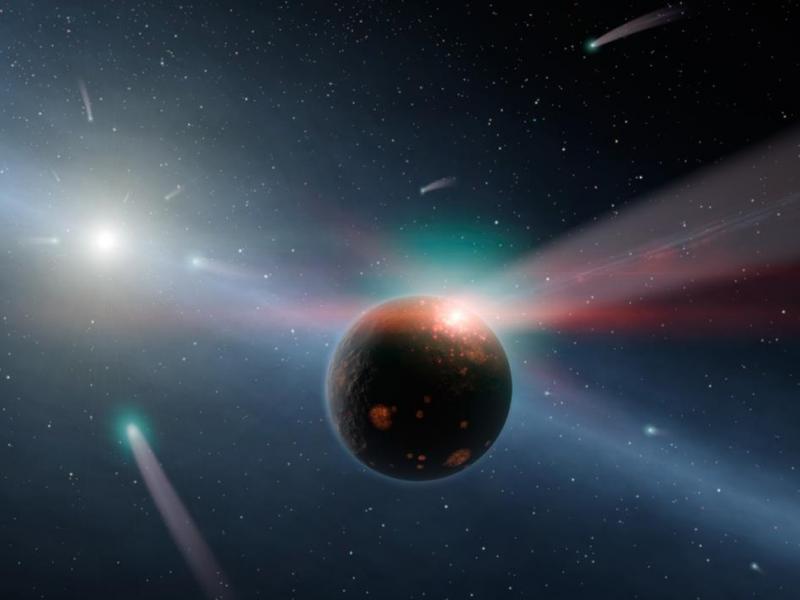A study quantifies the flow of materials that reach Earth from comets every day

Comets could have played an important role in the massive and efficient transport of water, organic matter, and volatile elements to the primitive Earth
A study led by Josep M. Trigo-Rodríguez, researcher of the Institute of Space Studies of Catalonia (IEEC — Institut d’Estudis Espacials de Catalunya) at the Institute of Space Sciences (ICE-CSIC), and Jürgen Blum, from the Institut für Geophysik und extraterrestrische Physik of the Technische Universität Braunschweig (Germany) tries to solve questions about the arrival of meteorites on our planet.
Among others, the study makes it possible to calculate the amount of fragments of asteroids and comets, the so-called meteoroids, that arrive at the top of the atmosphere of the Earth every day. According to this research, which compiles the efforts of several decades of research focused on the study of dozens of rainstorms of meteoroid particles in unprecedented detail, the total flow of meteoroids that reaches the Earth is more than 500 tons each year. Earlier estimates suggest a higher rate, suggesting that a large number of materials reach our planet having already been dispersed and altered in the interplanetary environment.

The passage of each comet generates millions of particles that first form dense curtains but
are later distributed / P. Biazzi et. al. / UJI.
The research examines how the flow of materials is reaching the Earth from comets and studies the relation between these materials and the interplanetary dust particles collected in the stratosphere.
"Our research is important in a cosmochemical and astrobiological framework because it has clear implications and allows us to make predictions about the primordial materials that reach our planet from comets," says researcher Josep M. Trigo.
Cometary aggregates are stuck together by a mixture of minerals of the order of micrometers (that is, one millionth of a meter), ice and organic compounds, so exposure to harsh space conditions causes their disintegration. Meteoroid streams lose mass and their density decreases until they eventually disappear on timescales of tens of thousands of years.
Consequently, most cometary particles that reach the Earth have sporadic origin, meaning they have evolved dynamically from comets and asteroids: due to the exposure for thousands or tens of thousands of years to the space weathering, these particles have been processed.

Example of a fireball as bright as the Moon detected on 4 January 2018 by Carlos Alcaraz from
Corbera de Llobregat (Barcelona) / Red SPMN.
At the following link you will find an informative video about the conclusions of the study.
Future implications
The quantification of the meteoric flow in different scenarios over time gives some clues about the main physical processes that contribute to the progressive disintegration of cometary matter in the interplanetary environment.
Among others, knowing the flow of meteoroids makes it possible to calculate the transport of water and volatile elements to the Earth. This transport, of key interest in an astrobiological context, occurs from the release of cometary particles into space.
This mechanism would only be efficient if comet fragmentation near the Earth in a remote past would have made it possible, since prolonged exposure to space modifies the content of volatile components. In this case, comets could have played an important role in the massive and efficient transport of water, organic matter, and volatile elements to the primitive Earth.
More information
This research is presented in a paper entitled “Learning about comets from the study of mass distributions and fluxes of meteoroid streams”, by Josep M Trigo-Rodríguez and Jürgen Blum, accepted to be published in the journal Monthly Notices of the Royal Astronomical Society.
The Institute of Space Studies of Catalonia (IEEC — Institut d’Estudis Espacials de Catalunya) promotes and coordinates space research and technology development in Catalonia for the benefit of society. IEEC fosters collaborations both locally and worldwide and is an efficient agent of knowledge, innovation and technology transfer. As a result of 25 years of high-quality research, done in collaboration with major international organisations, IEEC ranks among the best international research centers, focusing on areas such as: astrophysics, cosmology, planetary science, and Earth Observation. IEEC’s engineering division develops instrumentation for ground- and space-based projects, and has extensive experience in working with private or public organisations from the aerospace and other innovation sectors.
IEEC is a private non-profit foundation, governed by a Board of Trustees composed of Generalitat de Catalunya and four other institutions that each have a research unit, which together constitute the core of IEEC R&D activity: the University of Barcelona (UB) with the research unit ICCUB — Institute of Cosmos Sciences; the Autonomous University of Barcelona (UAB) with the research unit CERES — Center of Space Studies and Research; the Polytechnic University of Catalonia (UPC) with the research unit CTE — Research Group in Space Sciences and Technologies; the Spanish Research Council (CSIC) with the research unit ICE — Institute of Space Sciences. IEEC is a CERCA (Centres de Recerca de Catalunya) center.
Contacts
IEEC Communication Office
Barcelona, Spain
Ana Montaner and Sònia Bagudanch
E-mail: comunicacio@ieec.cat
Main IEEC researcher
Barcelona, Spain
Josep M. Trigo
Institute of Space Sciences (ICE-CSIC)
Institut d’Estudis Espacials de Catalunya (IEEC)
E-mail: trigo@ieec.cat, trigo@ice.csic.es
